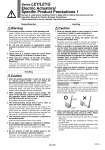
121-210-e-ley-en@@@102 / 104
10bãÉBOOKÌy[WÉÚ®µÜ·
Design/Selection Warning 1. Do not apply a load in excess of the operating limit. Select a suitable actuator by work load and allowable lateral load on the rod end. If the product is used outside of the operating limit, the eccentric load applied to the piston rod will be excessive and have adverse effects such as creating play on the sliding parts of the piston rod, degrading accuracy and shortening the life of the product. 2. Do not use the product in applications where excessive external force or impact force is applied to it. This can cause failure. 3. When used as a stopper, select the LEYG series gSliding bearingh for a stroke of 30 mm or less. 4. When used as a stopper, fix the main body with a guide attachment (gTop mountingh or gBottom mountingh). If the end of the actuator is used to fix the main body (end mounting), the excessive load acts on the actuator, which adversely affects the operation and life of the product. Handling Caution 1. When the pushing operation is used, be sure to set to gTorque control modeh, and use within the specified pushing speed range for each series. Do not allow the piston rod to hit the workpiece and end of the stroke in the gPosition control modeh, gSpeed control modeh or gPositioning modeh. The lead screw, bearing and internal stopper may be damaged and lead to malfunction. 2. When operating with gTorque control modeh, the value of the internal torque command (LECSA) or the maximum output command for analog torque (LECSB) should be set 30% or less. It may lead to damage and malfunction. 3. The forward/reverse torque limit is set to 100% (3 times the motor rated torque) as default. This value is the maximum torque (the limit value) in the gPosition control modeh, gSpeed control modeh or gPositioning modeh. When the product is operated with a smaller value than the default, acceleration when driving can decrease. Set the value after confirming the actual device to be used. 4. The maximum speed of this actuator is affected by the product stroke. Check the model selection section of the catalog. 5. Do not apply a load, impact or resistance in addition to the transferred load during return to origin. Additional force will cause the displacement of the origin position. 6. Do not scratch or dent the sliding parts of the piston rod, by striking or attaching objects. The piston rod and guide rod are manufactured to precise tolerances, even a slight deformation may cause malfunction. Handling Wrench Socket Caution 7. When an external guide is used, connect it in such a way that no impact or load is applied to it. Use a freely moving connector (such as a floating joint). 8. Do not operate by fixing the piston rod and moving the actuator body. Excessive load will be applied to the piston rod, leading to damage to the actuator and reduced the life of the product. 9. When an actuator is operated with one end fixed and the other free (ends tapped (standard), flange type), a bending moment may act on the actuator due to vibration generated at the stroke end, which can damage the actuator. In such a case, install a mounting bracket to suppress the vibration of the actuator body or reduce the speed so that the actuator does not vibrate. Also, use a mounting bracket when moving the actuator body or when a long stroke actuator is mounted horizontally and fixed at one end. 10. Avoid using the electric actuator in such a way that rotational torque would be applied to the piston rod. This may cause deformation of the non-rotating guide, abnormal responses of the auto switch, play in the internal guide or an increase in the sliding resistance. Refer to the table below for the approximate values of the allowable range of rotational torque. When screwing in a bracket or nut to the end of the piston rod, hold the flats of the rod end with a wrench (the piston rod should be fully retracted). Do not apply tightening torque to the non-rotating mechanism. Allowable rotational torque [N.m] or less LEY25ð® 1.1 LEY32 1.4 Series LEY/LEYG Electric Actuators/ Specific Product Precautions 1 Be sure to read before handling. Refer to page 469 for Safety Instructions and the Operation Manual for Electric Actuator Precautions. Please download it via our website, http://www.smcworld.com 11. When using auto switch with the guide rod type LEYG series, the following limits will be in effect. Please select the product while paying attention to this. ð Insert the auto switch from the front side with rod (plate) sticking out. ð The auto switches with perpendicular electrical entry cannot be used. ð For the parts hidden behind the guide attachment (Rod stick out side), the auto switch cannot be fixed. ð Consult with SMC when using auto switch on the rod stick out side. 219 A